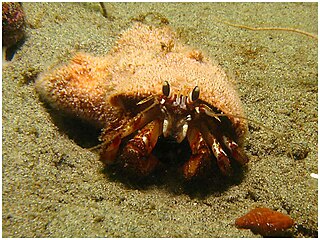
Hermit crabs are anomuran decapod crustaceans of the superfamily Paguroidea that have adapted to occupy empty scavenged mollusc shells to protect their fragile exoskeletons. There are over 800 species of hermit crab, most of which possess an asymmetric abdomen concealed by a snug-fitting shell. Hermit crabs' soft (non-calcified) abdominal exoskeleton means they must occupy shelter produced by other organisms or risk being defenseless.

Pagurus pollicaris is a hermit crab commonly found along the Atlantic coast of North America from New Brunswick to the Gulf of Mexico. It is known by a number of common names, including gray hermit crab, flat-clawed hermit crab, flatclaw hermit crab, shield hermit crab, thumb-clawed hermit crab, broad-clawed hermit crab, and warty hermit crab.

Pagurus bernhardus is the common marine hermit crab of Europe's Atlantic coasts. It is sometimes referred to as the common hermit crab or soldier crab. Its carapace reaches 3.5 centimetres (1.4 in) long, and is found in both rocky and sandy areas, from the Arctic waters of Iceland, Svalbard and Russia as far south as southern Portugal, but its range does not extend as far as the Mediterranean Sea. It can be found in pools on the upper shore and at the mean tide level down to a depth of approximately 140 metres (460 ft), with smaller specimens generally found in rock pools around the middle shore and lower shore regions, with larger individuals at depth. P. bernhardus is an omnivorous detritivore that opportunistically scavenges for carrion, and which can also filter feed when necessary.

Pagurus longicarpus, the long-wristed hermit crab, is a common hermit crab found along the Atlantic and Gulf coasts of the United States and the Atlantic coast of Canada.

Pagurus is a genus of hermit crabs in the family Paguridae. Like other hermit crabs, their abdomen is not calcified and they use snail shells as protection. These marine decapod crustaceans are omnivorous, but mostly prey on small animals and scavenge carrion. Trigonocheirus and Pagurixus used to be considered subgenera of Pagurus, but the former is nowadays included in Orthopagurus, while the latter has been separated as a distinct genus.

Oedignathus inermis is a species of king crab found off the Pacific coasts of the United States and Canada, from California to Alaska, and disjunctly around the coasts of Japan. It is the only species in the genus Oedignathus, and is sometimes called the granular claw crab, paxillose crab, or tuberculate nestling lithode crab.

Pagurus hirsutiusculus is a species of hermit crab, commonly called the hairy hermit crab. It lives from the Bering Strait south to California and Japan, from the intertidal zone to a depth of 110 m (360 ft).

Pagurus ikedai is a species of right-handed hermit crab in the family Paguridae.

Pagurus armatus, the armed hermit crab or black-eyed hermit crab, is a species of hermit crab found in the eastern Pacific Ocean of the United States and British Columbia, Canada.

Diogenes pugilator is a species of hermit crab, sometimes called the small hermit crab or south-claw hermit crab. It is found from the coast of Angola to as far north as the North Sea, and eastwards through the Mediterranean Sea, Black Sea and Red Sea. Populations of D. pugilator may be kept in check by the predatory crab Liocarcinus depurator.

Pagurus sinuatus is a large species of hermit crab found in Australia and the Kermadec Islands. It is red or orange in colour with coloured bands on the legs and patches on the body.

Pagurus samuelis, the blueband hermit crab, is a species of hermit crab from the west coast of North America, and the most common hermit crab in California. It is a small species, with distinctive blue bands on its legs. It prefers to live in the shell of the black turban snail, and is a nocturnal scavenger of algae and carrion.

Adamsia palliata is a species of sea anemone in the family Hormathiidae. It is usually found growing on a gastropod shell inhabited by the hermit crab, Pagurus prideaux. The anemone often completely envelops the shell and because of this it is commonly known as the cloak anemone or the hermit-crab anemone.

Pagurus prideaux is a species of hermit crab in the family Paguridae. It is found in shallow waters off the northwest coast of Europe and usually lives symbiotically with the sea anemone Adamsia palliata.
Pagurus forbesii is a species of hermit crab in the family Paguridae. It is found in the northeastern Atlantic Ocean and the Mediterranean Sea.

Pagurus acadianus, the Acadian hermit crab, is a species of hermit crab in the family Paguridae. It is found in Western Atlantic Ocean.

Neanthes fucata is a species of marine polychaete worm in the family Nereididae. It lives in association with a hermit crab such as Pagurus bernhardus. It occurs in the northeastern Atlantic Ocean, the North Sea and the Mediterranean Sea.

Pagurus dalli, commonly known as the whiteknee hermit or whiteknee hermit crab, is a species of hermit crab in the family Paguridae. It is found in the northeastern Pacific Ocean at depths down to about 276 m (900 ft). It usually lives in a mutualistic symbiosis with a sponge, or sometimes a hydroid.

Clistosaccus is a genus of barnacles which are parasitic on hermit crabs. It is a monotypic genus, and the single species is Clistosaccus paguri, which is found in the northern Atlantic Ocean and the northern Pacific Ocean.

















